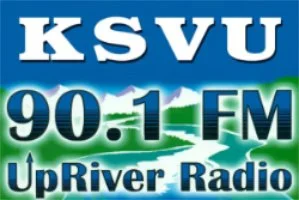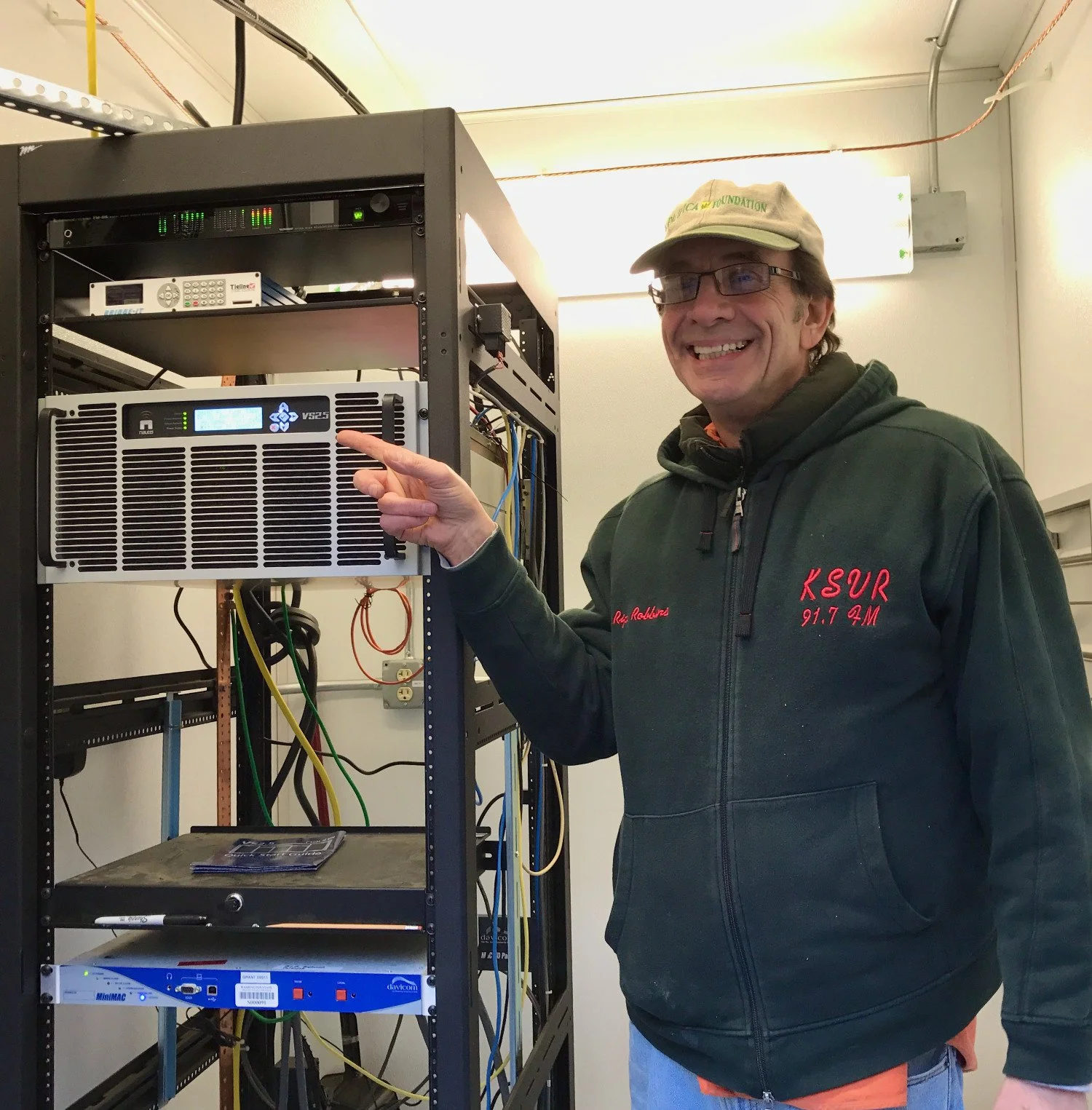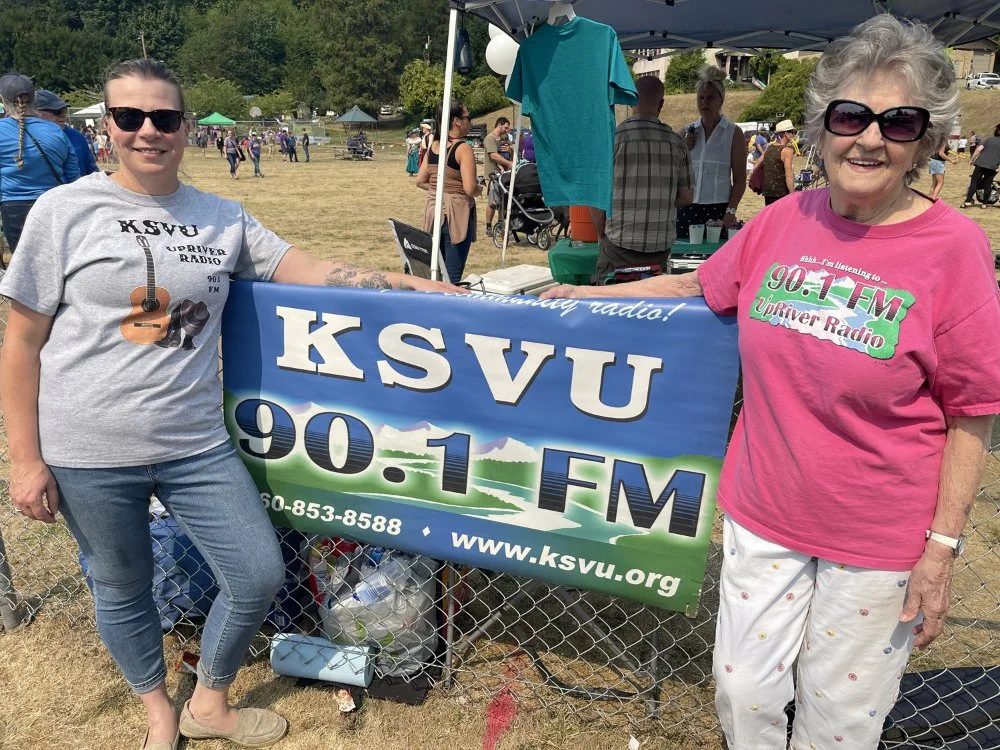About KSVU
KSVU-FM Hamilton Concrete, a full-service non-commercial educational FM radio station, is committed to providing the Upper Skagit Valley with local voices and content, including entertainment, news, and information.
KSVU’s on-air studio is located in Concrete, Washington in the Modular B building behind the Concrete Elementary School, with auxiliary studios and program origination in Mount Vernon co-located with KSVR-FM at Skagit Valley College.
Licensed to the Board of Trustees of Skagit Valley College, KSVU has been on the air since 2011. KSVU provides opportunities for community volunteers to produce radio programming that reaches local populations.
Installing KSVU’s antenna in the snow. (2011)
What’s the history of KSVU?
In 2007, the FCC announced it would be accepting applications for new non-commercial public radio stations. Using $5,000 from a KSVR contingency fund, and with approval from administrators at Skagit Valley College (SVC), KSVR general manager Rip Robbins hired an engineer to work out the potential for a radio station in the upper Skagit river valley, an area within the college’s district not served by the college’s existing radio station, KSVR in Mount Vernon. In 2008 the application for Hamilton-Concrete was granted and a three year FCC construction permit was issued. Hamilton was chosen as the station’s community of license because it was within 25 miles of the SVC Main Studio and within the 60dB contour of the signal, both FCC rules for Non-Commercial Educational licensees at the time.
Robbins applied for the U.S. Commerce Department Public Telecommunications Facilities Program (PTFP) grant program, which supported public broadcasting infrastructure, and using $37,000 in savings from KSVR and SVC to put toward a 75 percent match offered by the grant program. Robbins requested a project total of $147,000 to build the new station, $110,000 of which was matching grant funding. With the funding from KSVR, SVC, and the grant, the new radio station would have a foundation of solid high quality equipment. The grant application was approved and the college agreed to continue to help with administrative support, seeing the tremendous potential in outreach opportunities, for a relatively small investment.
First Broadcast
Just after 4 p.m., March 17, 2011 KSVU’s radio signal at 90.1 FM turned on for the first time, broadcasting at 330 watts effective radiated power (ERP). The FCC issued a license on April 8, 2011. This inaugural event marked the end of the beginning, so to speak: the end of over 3 years for the planning, permitting & construction phase.
KSVU ribbon cutting ceremony. (2011)
Erma Baude with the new console. (2018)
Growing Community Involvement
Things started out slowly at first, as they often do, with the majority of KSVU’s programming being an automated music mix, the independent news program Democracy Now!, as well as live and automated music and public affairs programs simulcast from sister station KSVR Mount Vernon.
In an effort to grow local involvement, Robbins secured the use of a modular building from the Concrete School District and a small radio broadcast and production studio was built. Jan Raschko became KSVU’s first volunteer station manager and together with SVC’s KSVR staff helped to bring in more community members. Since then KSVU has been fortunate to receive support from many community members who volunteered their time on the air and off the air as DJs, hosts, producers, engineers, fundraisers, organizers and managers.
Rip Robbins with the new transmitter. (2017)
Power Increase
In 2016, with help from an anonymous donor’s generous contribution towards engineering and equipment costs, KSVU was able to secure a construction permit (CP) from the FCC to increase its broadcast power to 2,050 watts. In early 2017 a new 2500 watt transmitter was purchased and installed, and KSVU’s power was officially increased to 2,050 watts.
A Changing of Flags
In 2018 Rip Robbins retired from SVC and Ed Jaramillo, SVC’s Vice President of Administrative Services, took over as manager of the KSVR and KSVU radio stations. In late 2019, the decision was made to exit KSVU’s commercial tower space lease due to budget constraints and begin the search for a new tower site. On January 9, 2020 KSVU’s FM signal went off the air and its transmission equipment was subsequently removed from the tower site. A Special Temporary Authority (STA) was filed with the FCC and approved to allow KSVU’s FM signal to remain off the air temporarily as the relocation efforts took place. At the same time KSVU began broadcasting over the internet.
Engineer Sam Roffe and one bay of KSVU's antenna. (2021)
COVID-19 Response
In response to the on-going COVID-19 pandemic both KSVU and KSVR stopped live broadcasts and production from their studios in March of 2020 and began automating all of their programming. During this period many DJs and program producers stayed on the radio by producing their shows from home, pre-recording them for automated broadcast.
Back on the Air
With help from the Hamilton Town Council and the Town of Hamilton an agreement was made to co-locate KSVU’s transmitter and antenna at a water tower site outside the town of Hamilton. In August of 2021, after filing with the FCC, KSVU’s FM signal went back on the air from the new water tower site transmitting at 1000 watts. Subsequently KSVU’s FCC license was renewed up to February 2030. Radio production remained remote until spring quarter of 2022, when DJs began to return to KSVU’s Concrete studio.
New KSVU Station Manager, Catherine Thuline, with previous Manager Erma Baude. (2023)
KSVU’S Future
We hope that you will join us to help write the next chapter of KSVU’s history as a community radio station for the Upper Skagit! We have time available for volunteer DJs, hosts, and producers, as well as other volunteer positions available. To learn more, visit our Volunteer page.
Mission Statement
Skagit Valley College cultivates student learning and achievement; contributes to the educational, personal, and economic success of students; and promotes equitable and thriving communities.
For complete mission, vision, and values, please visit the Skagit Valley College Strategic Plan 2019 - 2026.








